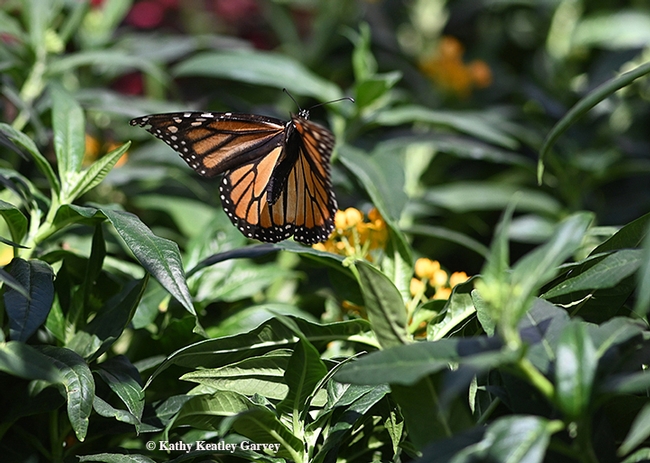- Author: Kathy Keatley Garvey
Welcome, Danaus plexippus!
A monarch butterfly, the first of the year, fluttered through our family pollinator garden in Vacaville, Calif. last Sunday and hung around for about two hours. We clocked him in at 5 p.m. and he exited around 7. He was on the move!
"Boy Butterfly" visited:
- the tower of jewels (Echium wildpretii)
- a yellow rose ("Sparkle and Shine," related to the Julia Child rose, a purchase from the California Center for Urban Horticulture, UC Davis, during its 2013 Rose Day
- a honeysuckle (genus Lonicera)
- a tropical milkweed (Asclepias curassavica) (it ignored the native "showy milkweed," Asclepias speciosa
- a butterfly bush (Buddleia davidii)
- a mallow (Althaea officinalis)
- a blooming succulent, hens-and-chicks (genus Echeveria): when it's blooming, it's referred to as a "rooster"
Then Boy Butterfly touched down on the ear of a cat (garden sculpture) while a mama California scrub jay watched closely. We could hear the baby birds chirping "We're hungry! We're hungry! Let's eat!"
Fortunately for the monarch, Mama's menu changed. She settled on some honey bees nectaring on the catmint (genus Nepeta), and left my Boy Butterfly alone.
A male European wool carder bee (Anthidium manicatum) chased him. A Gulf Fritillary followed him. And a bumble bee (Bombus vosnesenskii) almost collided with him.
And then this persistent photographer, armed with a 200mm macro lens, stealthily approached him...
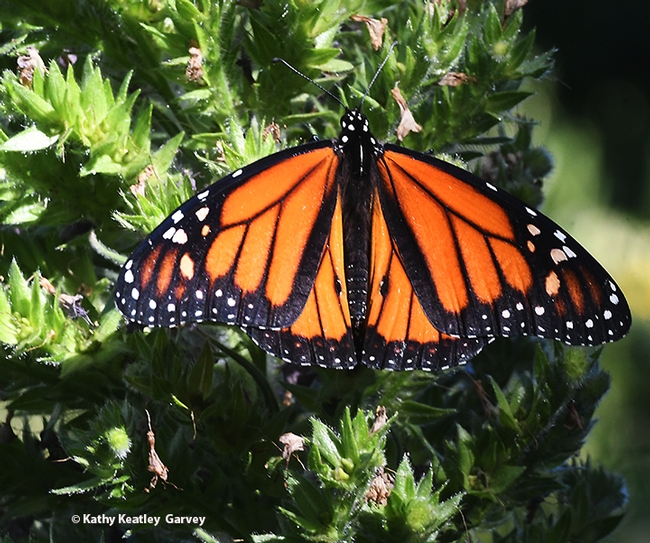
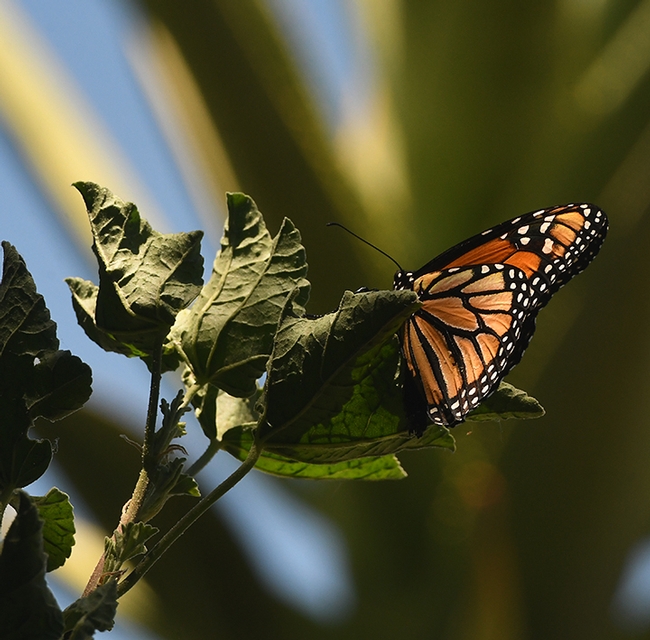
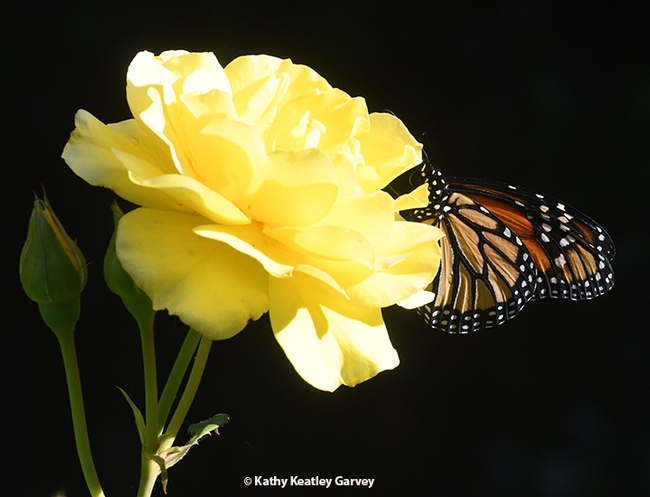
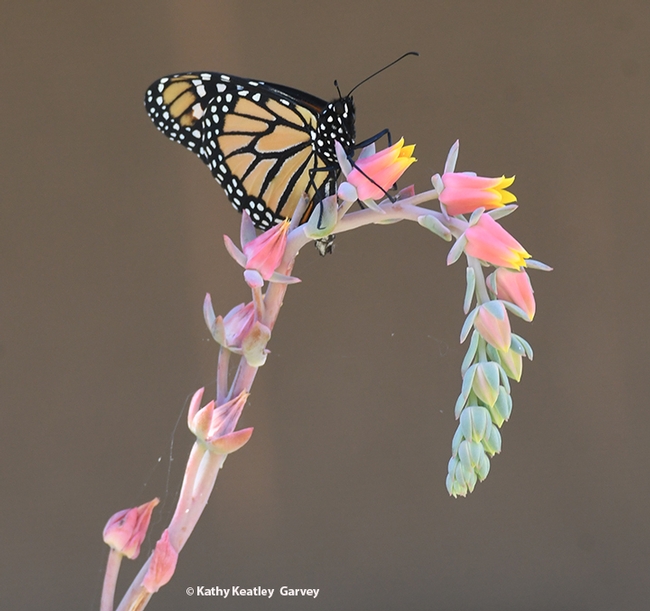
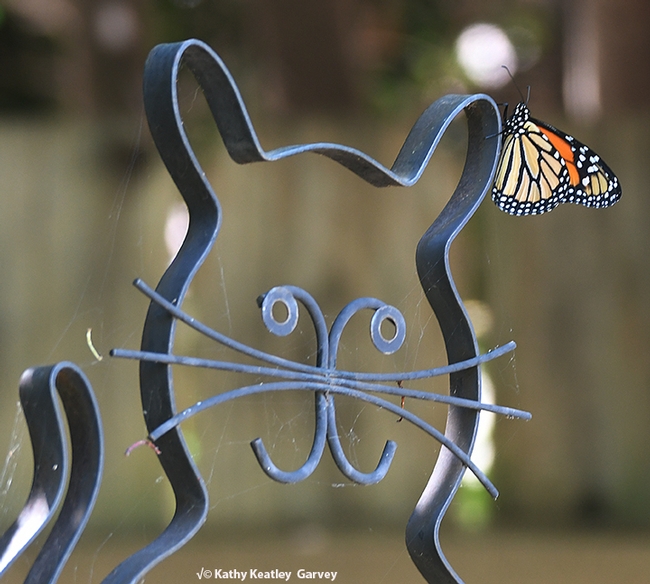
- Author: Kathy Keatley Garvey

Butterfly guru Art Shapiro, UC Davis distinguished professor of evolution and ecology, spotted a monarch in Sacramento on Wednesday, Jan. 29--way, way, way early to see monarchs in this area.
But it wasn't in his transect.
Shapiro, who maintains a research website at http://butterfly.ucdavis.edu/, has monitored butterfly population trends on a transect across central California since 1972. The 10 sites stretch from the Sacramento River Delta through the Sacramento Valley and Sierra Nevada mountains to the high desert of the Western Great Basin. The largest and oldest database in North America, it was recently cited by British conservation biologist Chris Thomas in a worldwide study of insect biomass.
But back to the monarch sighting.
As Shapiro tells it in his posse email: "We had a visitor today--a British journalist--who wanted to go on a site walk. Rancho Cordova was next up. We went in his rental car. We were on US 50, just passing the Tower Theater in Sacramento heading eastbound, when, at 10.30 a.m. (temperature in mid-upper 50s, light North wind, mostly sunny), a Monarch, sex unknown, flew across the freeway in front of us, 20-22' up, from SW to NE. There is no possibility of error, unless I am having visual hallucinations."
"I have had isolated January records before--mostly not at my sites, though, so I have to extract the data from my data books. The earliest record from a site is ii.1.14 (Feb. 1, 2014) from West Sacramento. All the other pre-March ones are: West Sacramento, ii.22.17, and Rancho Cordova, ii.22.92 and ii.23.06; and Gates Canyon (Vacaville), ii.24.91. In 1992 there were Monarchs in Rancho on iii.3,iii.17 and iii.31, too. 1992 was a drought year."
Later in the afternoon, Shapiro heard monarch Elizabeth Crone, professor of Tufts University, present a UC Davis Department of Entomology and Nematology seminar on the decline of Western monarchs.
In her seminar, Crone expressed concern about the lack of scientific knowledge about monarchs when they emerge from their overwintering sites along coastal California, usually around February, and head inland. Her "main punchline was that we don't know what they're doing between February and when milkweeds break ground later in spring," Shapiro related in his email. "I recommend cruising around in the Coast Range, particularly in Napa and Sonoma counties, looking for them. Of course, this year the total population is so small that the probability of seeing one would be comparable to that on Highway 50 this morning before the fact..."
In a later posse email, Shapiro related that "it turns out we have only one previous January monarch record, and it's from Louie Yang (associate professor, UC Davis Department of Entomology and Nematology), not me, on i.8.2012 in East Davis. There was another record here on ii.19.12. I had one on ii.10.98 in West Davis, near Stonegate. That's it!"
Interestingly enough, Shapiro saw his first monarch of the year before he saw his first cabbage white butterfly of the year! He annually sponsors a contest, "Butterfly for a Beer," or "Suds for a Bug," as part of his research. The first person to collect a live cabbage white butterfly (Pieris rapae) in the three-county area of Sacramento, Yolo and Solano, wins a pitcher of beer or its equivalent. Since 1972, when he launched the contest, the first flight has varied from Jan. 1 to Feb. 22, averaging about Jan. 20. Last year Shapiro collected the contest winner on Jan. 25 near the Suisun Yacht Club, Solano County.
However, as Jan. 29, no sightings and no winner of the 2020 Cabbage White Butterfly Contest.
The score: Monarch, 1, Cabbage White, 0.
(Update: Shapiro sighted a cabbage white butterfly on Jan. 30 at the Putah Creek Nature Park, Winters, Yolo County, but did not collect it. He spotted it basking on a malva leaf at 11:16 a.m., but it took off before he could net it. So, since no collection, no voucher, Shapiro did not declare himself the winner. "Now that I know the bug is out, there's no scientific reason to want more records," he wrote in a posse email. "To be fair to potential competitors, the first person to catch a rapae in the contest area before 5 p.m., Sunday, Feb. 2, wins the beer. I will not try to beat them to a voucher." See rules. Shapiro says this was the latest first flight date for Valley rapae since Jan. 31, 2011.)
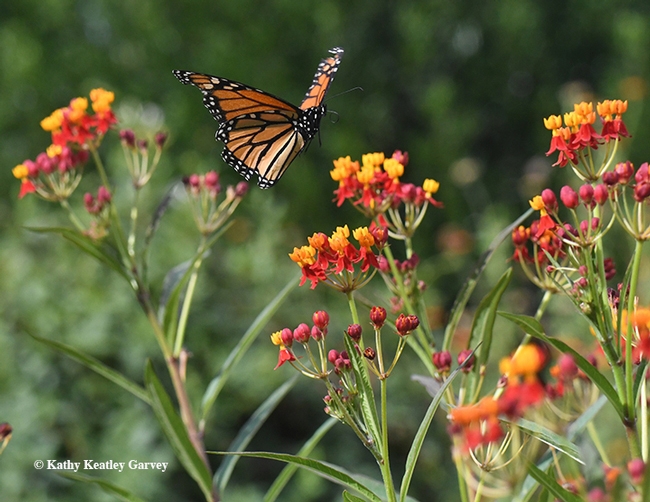
- Author: Kathy Keatley Garvey
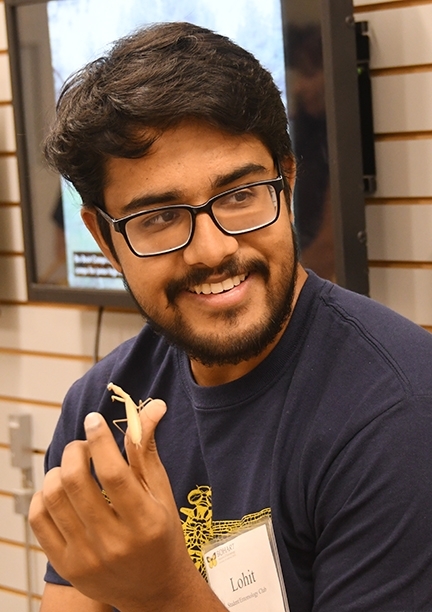
Scientists at the UC Davis Bohart Museum of Entomology will help you do just that.
They've scheduled an open house on “Arthropod Husbandry: Raising Insects for Research and Fun” from 1 to 4 p.m., Saturday, Nov. 16 in Room 1124 of the Academic Surge Building on Crocker Lane. It's free and family friendly.
"We will have a number of people who are expert at raising insects, both for research and for fun," said Tabatha Yang, Bohart Museum education and outreach coordinator. UC Davis student Andrew Goffinet, a former UC Davis Bio Boot Camper, will be on hand to talk about rearing butterflies and moths. UC Davis entomology alumnus Lohit Garikipati will discuss praying mantids.
Another entomology alumnus Nicole Tam, will talk about rearing insects in the Geoffrey Attardo lab as part of research projects. Doctoral student and Bohart associate Zaid Khouri's topic is how to rear tarantulas and millipedes for fun.
"We also will be discussing Madagascar hissing cockroaches (hissers) as good options for 'starter pets' for kids, and some of the problems with stick insects (walking sticks)," Yang said. Visitors are invited to hold the hissers and stick insects and photograph them.
At 3 p.m., silkworm moth expert İsmail Şeker, a Turkish medical doctor who wrote a book about silkworm moths and the cottage silk industry in his home town, will show his newly produced video about the silkworm moth life cycle. Seker, also a talented videographer and a photographer, will answer questions following his 13-minute video presentation.
"This will be a fun open house for anyone considering a pet with an exoskeleton," Yang said."It will be good for educators to learn about classroom 'pets,' including those who do work with silk moths for life cycle lesson plans."
"Also, to kick off the holiday season we will have the unique wire jewelry by former entomology major Ann Kao, so people should be prepared to shop for some unique insect-inspired jewelry."
A family craft activity is also planned. This is the last open house of the year. The next open house will be on Jan. 18 when UC Davis graduate students from many different fields "will be talking/displaying about their cutting edge research with insects," Yang said.
The Bohart Museum houses a global collection of nearly eight million specimens. It is also the home of the seventh largest insect collection in North America, and the California Insect Survey, a storehouse of the insect biodiversity. Noted entomologist Richard M. Bohart (1913-2007) founded the museum. It maintains a live "petting zoo," featuring Madagascar hissing cockroaches, walking sticks or stick insects and tarantulas. The museum's gift shop, open year around, is stocked with T-shirts, sweatshirts, books, jewelry, posters, insect-collecting equipment and insect-themed candy.
Director of the museum is Lynn Kimsey, professor of entomology at UC Davis. The staff includes Steve Heydon, senior museum scientist; Tabatha Yang, education and outreach coordinator; and Jeff Smith, who curates the Lepidoptera (butterflies and moths) section.
More information on the Bohart Museum is available on the website at http://bohart.ucdavis.edu or by contacting (530) 752-0493 or bmuseum@ucdavis.edu.
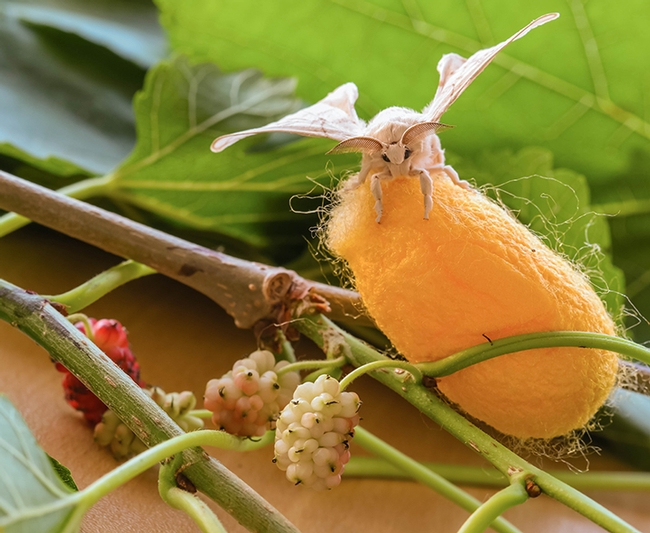
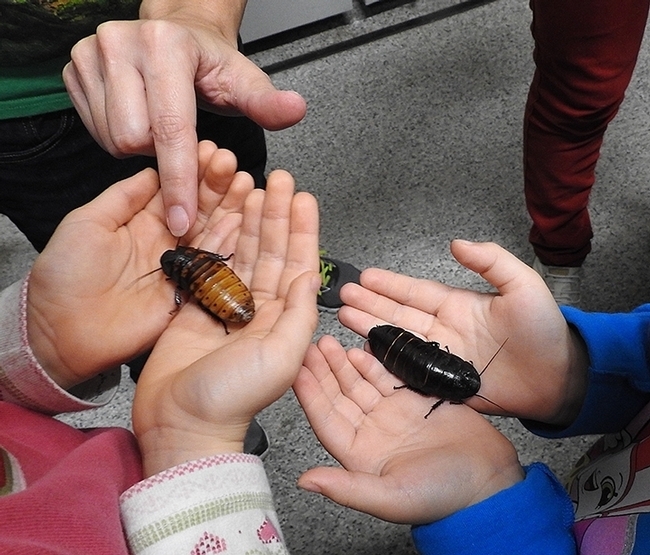
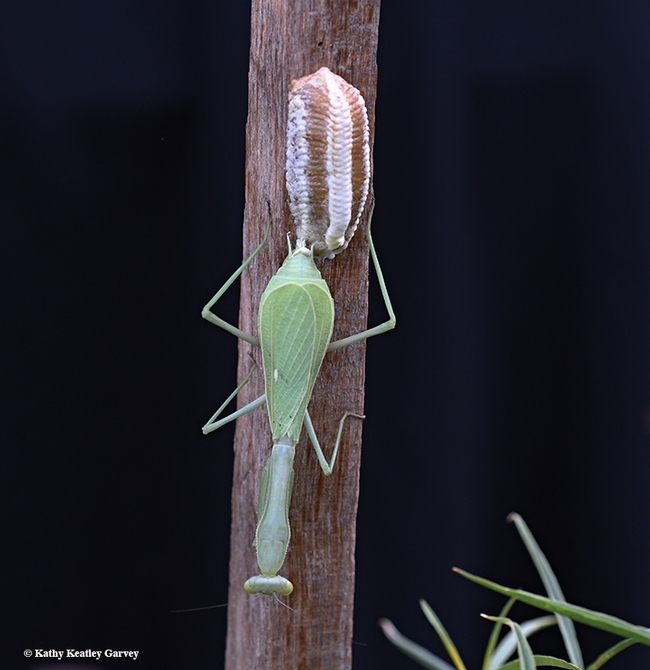
- Author: Kathy Keatley Garvey
A monarch butterfly fluttered into our pollinator garden in Vacaville yesterday and sipped nectar from a Mexican sunflower (Tithonia) as a bird looked on.
Well, sort of looked on.
The bird was decorative art. The monarch was real.
Now if that bird had been real, the monarch may have been a meal.
It would not have tasted very good, though, due to the infamous cardenolide defense, which the monarch gets in its caterpillar stage while chowing down milkweed, its host plant.
Yes, birds eat monarch butterflies, but they don't eat them like people eat potato chips.
We remember the Linda Fink-Lincoln Brower research article published in May 1981 in the journal Nature about how some birds can overcome the cardenolide defense of monarch butterflies in Mexico.
The abstract:
"Flocks of black-backed orioles (Icterus abeillei Lesson) and black-headed grosbeaks (Pheucticus melanocephalus Swainson) eat several hundred thousand monarch butterflies (Danaus plexippus L.) in the dense overwintering colonies in central Mexico, and in 1979 were responsible for over 60% of the butterfly mortality at several sites. Such predation is unusual because, during larval development the aposematically coloured monarch butterfly sequesters cardenolides from its milkweed foodplants (Asclepiadaceae). These bitter-tasting heart poisons cause vomiting in 12 species of birds in 9 families, although the domestic chicken, Japanese quail, hedgehog, mouse and sheep have been shown to be insensitive to their emetic effects. Extensive predation of monarch butterflies by birds has never been observed except in Mexico. We report here that the Mexican butterflies are weakly emetic, and that taste discrimination by orioles and cardenolide insensitivity of grosbeaks allow these birds to feed freely on monarch butterflies."
We've seen birds scatter the overwintering monarchs roosting in the eucalyptus trees at Pacific Grove, Santa Cruz, but never witnessed an all-you-can-eat buffet. They ate a few, though.
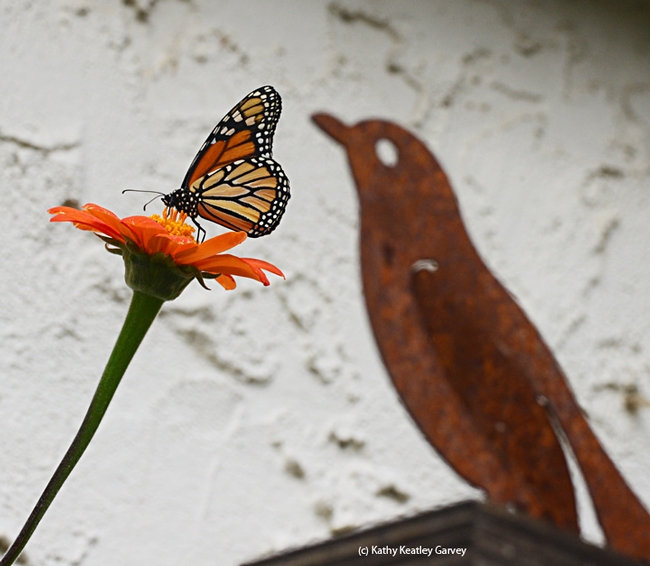
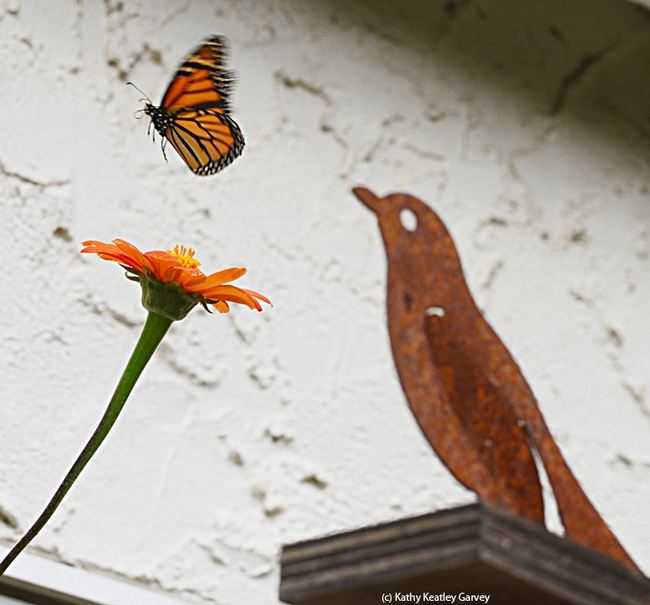
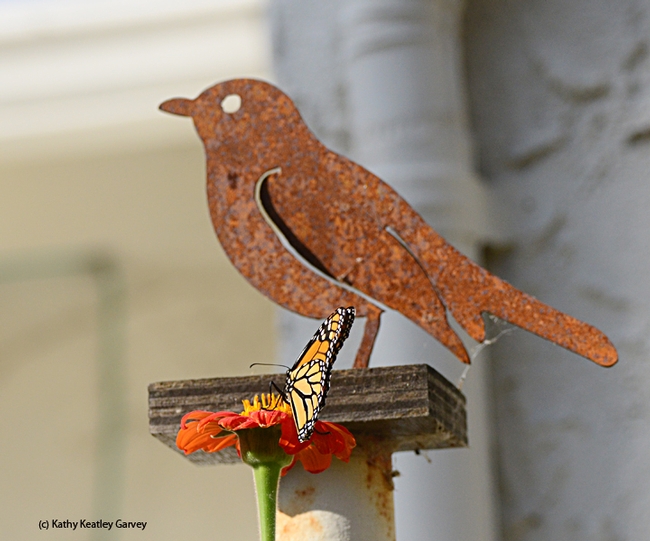
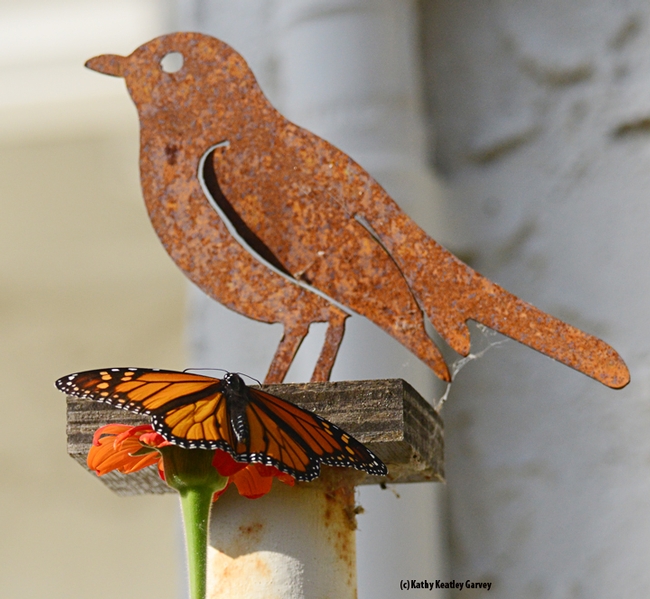
- Author: Kathy Keatley Garvey
What are the odds?
Here you are, standing in the garden section of a home improvement store, and you select a tropical milkweed to purchase. You place it on the ground and admire the brilliant yellow blossoms and luxurious green foliage. It's the best of the best. Just as you're about to pick it up and place it in a cart, a monarch lands on it and begins laying eggs.
What are the odds?
That happened to us around Wednesday noon, Sept. 4 in Vacaville as we were purchasing an end-of-the-season Asclepias curassavica.
Most likely, the plant had been in the nursery since last spring, as it was root-bound. We took it home, replanted it in a larger pot, and set it in the sun. Milkweeds like full sun. And monarchs go where their host plant is, whether it be in the wild, in your backyard, in your city park, or in a garden section of your local home improvement store.
Hopefully, the monarch eggs will hatch and this tropical milkweed will yield some caterpillars, chrysalids and adults.
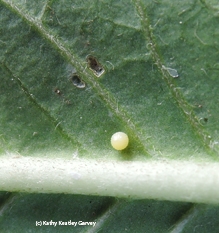
Ironically, we found a monarch laying eggs in the garden section of a home improvement store!
Said entomologist David James of Washington State University, Pullman, who researches migratory monarchs: "That's an amazing story...selecting your milkweed and then having a female come over and deposit a few eggs for you!"
As an aside, as we were purchasing the milkweed, I casually asked the clerk at the check-out line "Have you seen any monarchs here?"
"Not in HERE," she said, surprised I would ask such a question. She tallied up the sale as "Mama Monarch" fluttered around her nursery, unnoticed, laying the next generation.
Curiously enough, a family member recorded a monarch laying eggs in the garden section of that same store the day before. About the same time. Maybe the same monarch. (See YouTube video)
Butterfly guru Art Shapiro, UC Davis distinguished professor of evolution and ecology, who has monitored all butterfly populations in the central valley for more than four decades and publishes his research on a website, says that “this is the biggest milkweed year in northern and central California in living memory. Speciosa is up to 5' tall and some fascicularis almost as big, and both are covered with both genera of Lygaeids (milkweed bugs), plus both oleander and gray aphids. But Monarchs only showed up here about two weeks ago! Lots of milkweed, no Monarchs to use it. I have seen 10 Monarchs in 2019 and have not seen a wild larva since 2017, and I am afield 260 days a year.”
Sometimes life just isn't fair. Entomologist Lynn Kimsey, director of the Bohart Museum of Entomology and professor of entomology at UC Davis, commented “Weirder and weirder. They still haven't found MY milkweed.”
